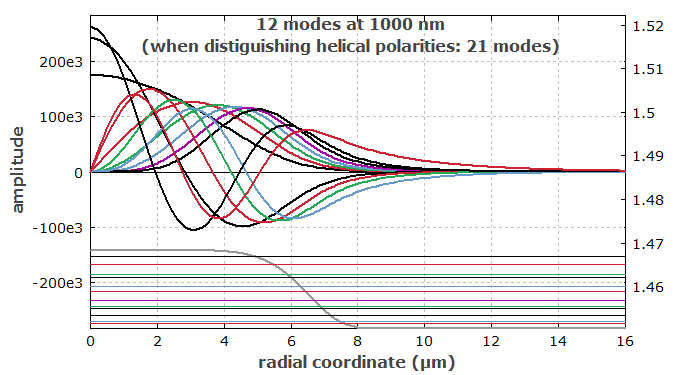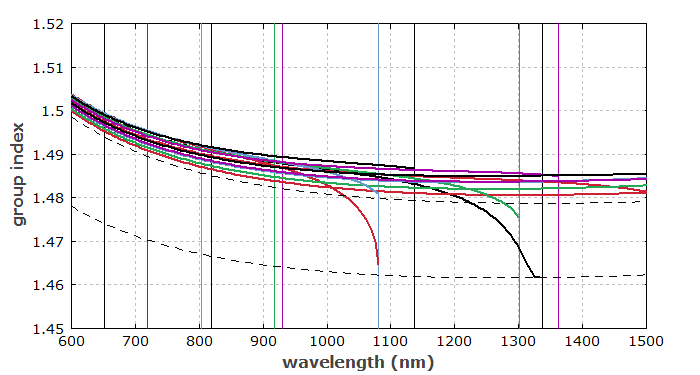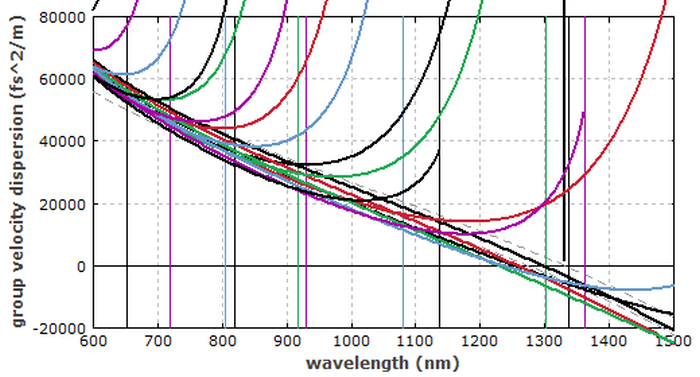Passive Fiber Optics
This is part 10 of a tutorial on passive fiber optics from Dr. Paschotta. The tutorial has the following parts:
1: Guiding light in a glass fiber, 2: Fiber modes, 3: Single-mode fibers, 4: Multimode fibers, 5: Fiber ends, 6: Fiber joints, 7: Propagation losses, 8: Fiber couplers and splitters, 9: Polarization issues, 10: Chromatic dispersion of fibers, 11: Nonlinearities of fibers, 12: Ultrashort pulses and signals in fibers, 13: Accessories and tools
Part 10: Chromatic Dispersion of Fibers
Chromatic dispersion is the phenomenon that the phase velocity and the group velocity of light propagating in a fiber depend on the optical frequency. It is relevant for many applications of fiber optics. For example, it has a strong influence on the propagation of telecom signals in optical fiber communications and on the propagation of ultrashort pulses.
Origins of Chromatic Dispersion
In optical fibers, dispersion arises from two totally different origins:
- The glass material has some material dispersion, which applies e.g. to a plane wave propagating in a homogeneous piece of that glass. This means that the refractive index is wavelength-dependent.
- There is also waveguide dispersion: the chromatic dispersion is modified due to the fact that in a fiber we do not have plane waves (even though the fiber modes usually have plane wavefronts), but spatially confined light waves.
Understanding Waveguide Dispersion
Waveguide dispersion is more easily understood by considering a somewhat artificial case: a step-index fiber where the fiber core, seen from an end face, is has a square instead of circular shape, with a width a in x and y direction. We also assume a high index contrast, so that at least the low-order modes have essentially no intensity outside the core. In this situation, each mode field is (within the fiber core) essentially a superposition of four plane waves. There are two with a wave vector component in ±x direction and two more with a wave vector in ±y direction.
As the mode field must vanish at the edges of the core, the x components of the wave vector must satisfy the condition kx a = jx π with a positive integer mode index jx. (kx is the phase advance per unit length in x direction.) An analogous rule holds for the y direction. Figure 1 shows the transverse amplitude profile for jx = 3 and jy = 4.

For the chromatic dispersion, what matters is the phase advance in z direction. The phase constant is:

This results from a simple calculation: we have a certain magnitude of the wave vector, determined by the wavelength and the refractive index n of the core, and that wave vector has transverse and longitudinal components which add up according to the law of Pythagoras.
We see now that higher-order modes have lower phase constants β, basically because their wave vector components are more strongly tilted against the fiber axis. This means that their phase velocities vph = ω / β are higher than that of the fundamental (lowest-order) mode.
The group velocity is the inverse of the derivative dβ / dω. As each mode has wavelength-independent transverse components, its β rises faster with frequency for higher-order modes. (The increase of 2πn / λ with increasing frequency without an increase of the transverse component means a faster rise of the longitudinal component.) Therefore, higher-order modes have lower group velocities.
Dispersion of a Multimode Fiber
In a real fiber, we normally have a more complicated situation due to a circular symmetry, possibly smooth index profiles and modes which extend significantly into the cladding. However, various basic aspects are essentially the same as in the example discussed above. As a more realistic example, let us look at the modes of a multimode germanosilicate fiber. Figure 2 shows the index profile and the radial mode functions.

Figure 3 shows the group indices of the modes. (The group velocity is c divided by the group index.) They rise at short wavelengths due to the material dispersion. The two gray dashed curves show the values for the core (at its center) and the cladding; the group indices of the modes a largely higher than these two, already indicating the additional effect of waveguide dispersion.

Near a mode cut-off, the group index often drops, i.e., the group velocity rises. This is related to the weaker mode confinement in that regime. For modes with l = 0 (black curves), the group velocity can approach that of the cladding.
We can finally look at the group velocity dispersion. This is essentially the frequency derivative of the group velocity. Figure 4 shows how the group velocities of all modes evolve with wavelength. These are normally between the values for core and cladding at wavelengths far below mode cut-off, and rise for wavelengths close to cut-off.

(See also a more complete description of the used simulation model.)
Of course, the dispersion properties depend on the detailed refractive index profile. This gives us the opportunity, for example, to tailor the dispersion properties of telecom fibers. That is done particularly for single-mode fibers used in long-haul data transmission. For example, there are dispersion-shifted fibers with a W-shaped index profile, where the zero dispersion wavelength has been shifted from the 1.3-μm region (where it would naturally be for single-mode silica fibers) to the 1.5-μm region, where modern telecom systems using erbium-doped fiber amplifiers operate. Zero dispersion is actually not always beneficial; one also uses dispersion-flattened fibers, having a reduced wavelength dependence of the group velocity dispersion, i.e., low higher-order dispersion.
Unfortunately, one cannot obtain arbitrary dispersion profiles. For the common all-glass fibers, there are serious limitations. For example, one cannot obtain anomalous dispersion (negative GVD) in the visible wavelength range. Note also that one cares about various aspects, e.g. effective mode area, bend losses and fabrication tolerances, and there can be trade-offs.
A far higher degree of dispersion control is possible with photonic crystal fibers, containing tiny air holes. The placement of air holes gives a lot of room for optimizations. Here, one can e.g. obtain anomalous dispersion in the visible wavelength range. Note that calculations are more difficult for such fibers, having a high refractive index contrast, and partly being based on different light guiding principles.
Note, however, that none of these approaches has a potential for dispersion control in large mode area fibers. Such large modes always have phase constants (β values) close to the wavenumber in the corresponding fiber core material, with very small effects of waveguide dispersion. This is essentially because large modes have a similar dispersion behavior like plane waves, with weak diffraction and waveguiding effects.
Dispersion in Fiber-optic Links
One might think that chromatic dispersion is always bad for the transmission of telecom signals in fiber-optic links, as it tends to temporally spread and distort signals. Indeed, chromatic dispersion (as well as intermodal dispersion) can introduce a dispersion power penalty, i.e., one needs more optical power to achieve the same bit rate. Therefore, it appeared for a while that one should either operate fiber-optic links in the 1.3-μm wavelength region, close to the zero-dispersion wavelength (ZDW) of standard silica fibers, or use dispersion-shifted fibers with the ZDW in the 1.5-μm wavelength region, where erbium-doped fiber amplifiers can be used. It turned out, however, that particularly when using wavelength division multiplexing it is better to have some amount of dispersion, as that mitigates nonlinear effects. See part 11 on fiber nonlinearities and part 12 on pulses and signals for some more details.
Go to Part 11: Nonlinearities of Fibers or back to the start page.
Questions and Comments from Users
Here you can submit questions and comments. As far as they get accepted by the author, they will appear above this paragraph together with the author’s answer. The author will decide on acceptance based on certain criteria. Essentially, the issue must be of sufficiently broad interest.
Please do not enter personal data here; we would otherwise delete it soon. (See also our privacy declaration.) If you wish to receive personal feedback or consultancy from the author, please contact him e.g. via e-mail.
By submitting the information, you give your consent to the potential publication of your inputs on our website according to our rules. (If you later retract your consent, we will delete those inputs.) As your inputs are first reviewed by the author, they may be published with some delay.



These sharing buttons are implemented in a privacy-friendly way!



